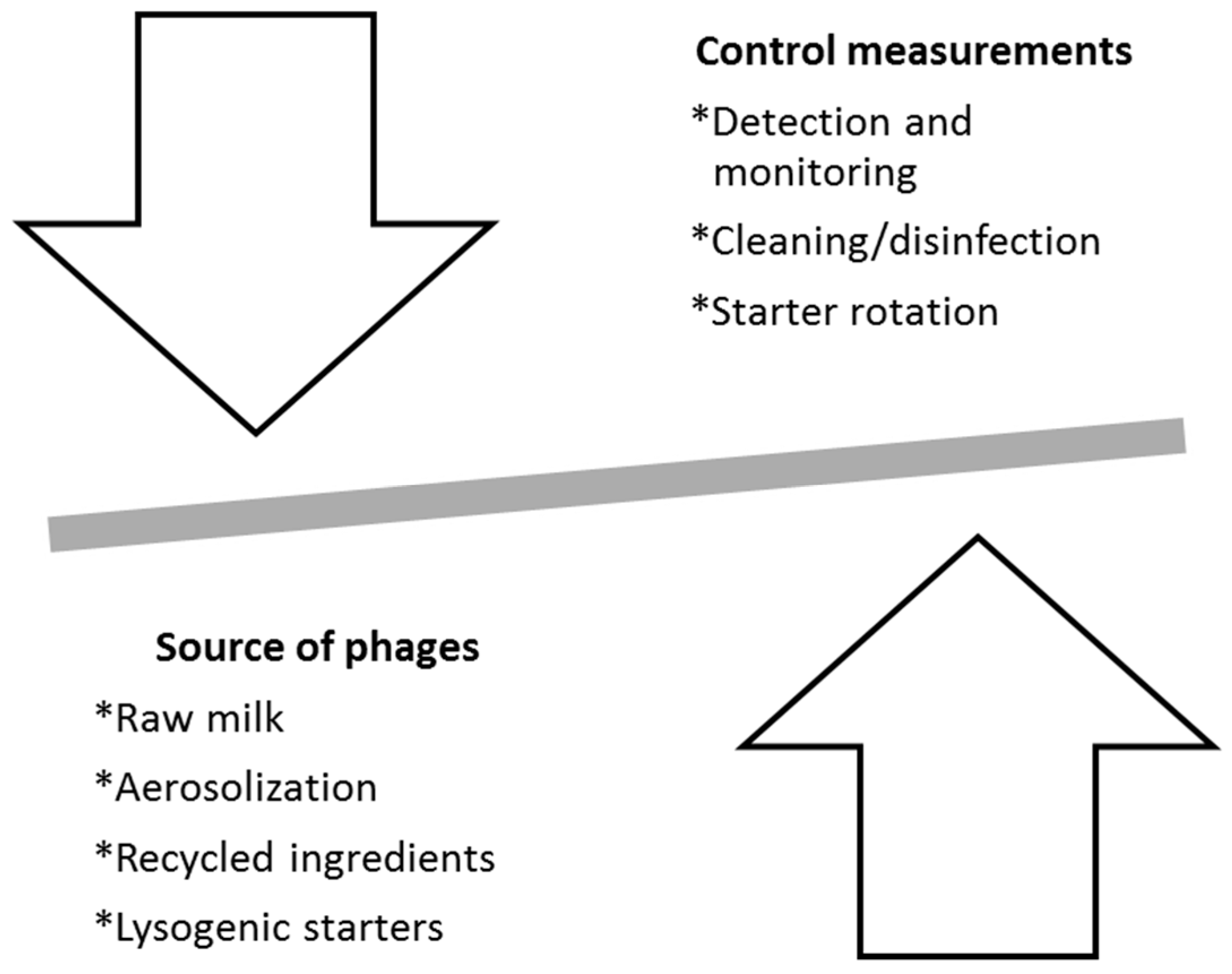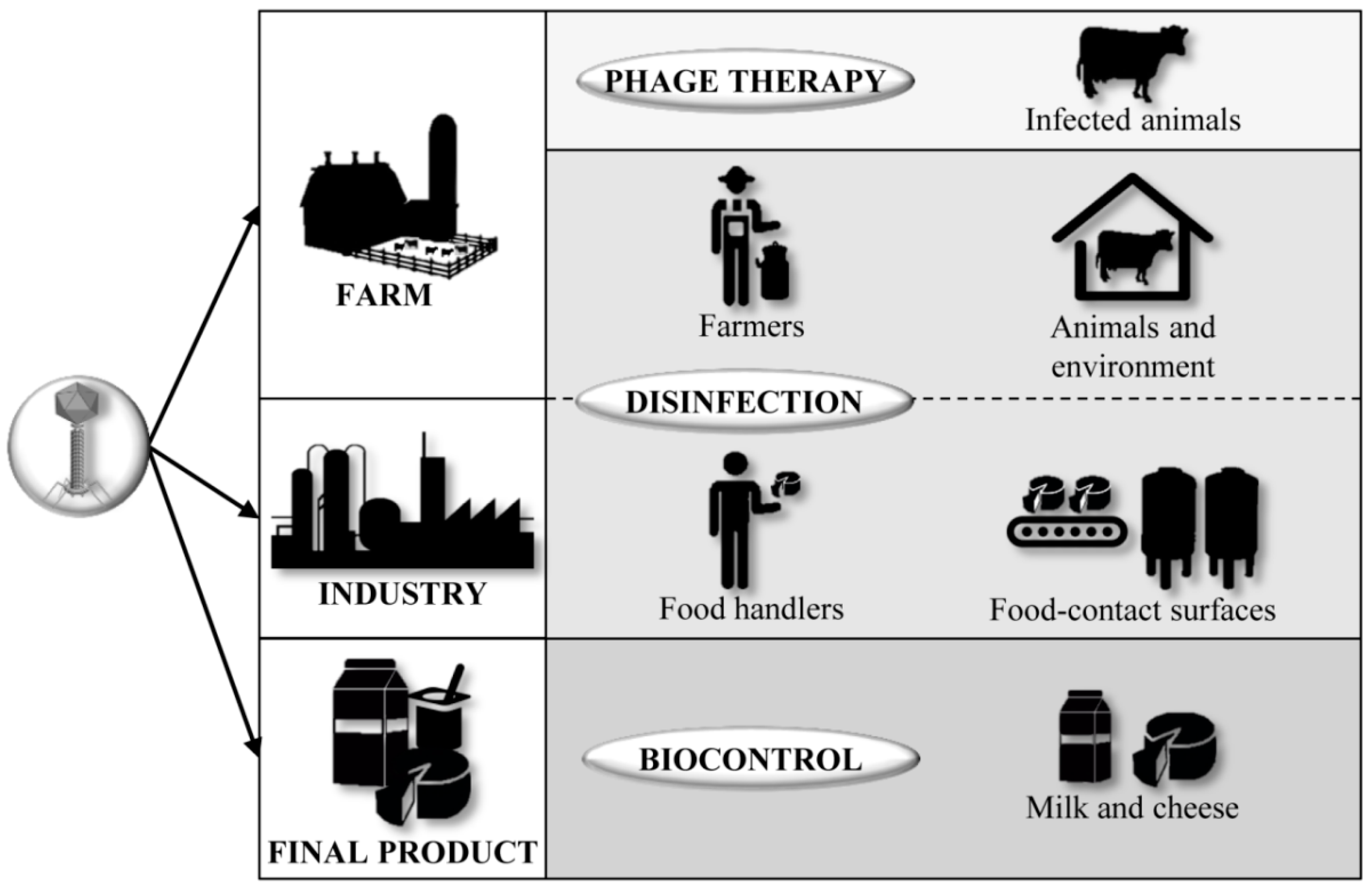Bacteriophages in the Dairy Environment: From Enemies to Allies
Abstract
:1. Introduction
1.1. Origins and Industrialization of Dairy Production
1.2. Economic Importance of the Dairy Industry in Different Countries
2. Bacteriophages as Unwanted Guests
2.1. Sources of Contamination
2.2. Detection and Elimination
2.3. Control Methods
3. Problems Associated with Bacterial Contamination
3.1. Foodborne Infectious Diseases in Dairy Products
3.2. Antimicrobial Resistance in the Dairy Environment
4. Bacteriophages as Unexpected Allies
4.1. Phages as Disinfectants and Preservatives in the Dairy Industry
4.2. Regulatory Framework for the Application of Phage-Derived Products in the Food Industry
5. Concluding Remarks
Acknowledgments
Author Contributions
Conflicts of Interest
References
- Rodríguez González, A.; Roces Rodríguez, C.; Martínez Fernández, B. Chapter 9: Cultivos Iniciadores en Quesería: Tradición y Modernidad. In Biocontrol en la Industria Láctea; Roa, I., Pacheco, M., Tabla, R., Rebollo, J.E., Eds.; Bubok Publishing, S.L.: Madrid, Spain, 2014; pp. 110–125. ISBN 978-84-686-5316-7. (In Spanish) [Google Scholar]
- Dugdill, B.; Bennett, A.; Phelan, J.; Scholten, B.A. Chapter 8: Dairy-industry development programmes: Their role in food and nutrition security and poverty reduction. In Milk and Dairy Products in Human Nutrition; Muehlhoff, E., Bennett, A., McMahon, D., Eds.; FAO: Rome, Italy, 2013; pp. 313–348. ISBN 978-92-5-107863-1. [Google Scholar]
- Kongerslev Thorning, T.; Raben, A.; Tholstrup, T.; Soedamah-Muthu, S.S.; Givens, I.; Astrup, A. Milk and dairy products: Good or bad for human health? An assessment of the totality of scientific evidence. Food Nutr. Res. 2016, 60. [Google Scholar] [CrossRef]
- Chandan, R.C. Dairy Industry: Chapter 2: Production and Consumption Trends. In Dairy Processing & Quality Assurance; Chandan, R.C., Kilara, A., Schah, N.P., Eds.; Wiley-Blackwell: Ames, IA, USA, 2008; pp. 41–58. ISBN 978-0813827568. [Google Scholar]
- Moncada Jiménez, A.; Pelayo Consuegra, B.H. Chapter 4: El Proceso Industrial de los Productos Lácteos. In El libro blanco de la Leche y los Productos Lácteos; Cámara Nacional de Industriales de la Leche: Mexico City, Mexico, 2011; pp. 52–65. [Google Scholar]
- Visioli, F.; Strata, A. Milk, dairy products, and their functional effects in humans: A narrative review of recent evidence. Adv. Nutr. 2014, 5, 131–143. [Google Scholar] [CrossRef] [PubMed]
- Chandan, R.C. Chapter 1: Dairy Processing and Quality Assurance: An Overview. In Dairy Processing & Quality Assurance; Chandan, R.C., Kilara, A., Schah, N.P., Eds.; Wiley-Blackwell: Ames, IA, USA, 2008; pp. 1–38. ISBN 978-0813827568. [Google Scholar]
- OECD/FAO. OECD-FAO Agricultural Outlook 2016–2025; OECD Publishing: Paris, France, 2016; ISBN 9789264253223. [Google Scholar]
- International Dairy Federation. The IDF Guide on Biodiversity for the Dairy Sector; Bulletin of the International Dairy Federation; International Dairy Federation: Schaerbeek, Belgium, 2017; Volume 488. [Google Scholar]
- FAO. Food Outlook Biannual Report on Global Food Markets; FAO: Rome, Italy, 2016; ISSN 0251-1959. [Google Scholar]
- Hemme, T.; Uddin, M.M.; Oghaiki Asaah Ndambi, O.A. Benchmarking cost of milk production in 46 countries. J. Rev. Glob. Econ. 2014, 3, 254–270. [Google Scholar]
- Samson, J.E.; Moineau, S. Bacteriophages in food fermentations: New frontiers in a continuous arms race. Annu. Rev. Food Sci. Technol. 2013, 4, 347–368. [Google Scholar] [CrossRef] [PubMed]
- Kleppen, H.P.; Bang, T.; Nes, I.F.; Holo, H. Bacteriophages in milk fermentations: Diversity fluctuations of normal and failed fermentations. Int. Dairy J. 2011, 21, 592–600. [Google Scholar] [CrossRef]
- Madera, C.; Monjardin, C.; Suarez, J.E. Milk contamination and resistance to processing conditions determine the fate of Lactococcus lactis bacteriophages in dairies. Appl. Environ. Microbiol. 2004, 70, 7365–7371. [Google Scholar] [CrossRef] [PubMed]
- Del Rio, B.; Binetti, A.G.; Martin, M.C.; Fernandez, M.; Magadan, A.H.; Alvarez, M.A. Multiplex PCR for the detection and identification of dairy bacteriophages in milk. Food Microbiol. 2007, 24, 75–81. [Google Scholar] [CrossRef] [PubMed]
- Verreault, D.; Moineau, S.; Duchaine, C. Methods for sampling of airborne viruses. Microbiol. Mol. Biol. Rev. 2008, 72, 413–444. [Google Scholar] [CrossRef] [PubMed]
- Neve, H.; Berger, A.; Heller, K.J. A method for detecting and enumerating airborne virulent bacteriophage of dairy starter cultures. Kieler Milchwirtschaftliche Forschungsberichte 1995, 47, 193–207. [Google Scholar]
- Verreault, D.; Gendron, L.; Rousseau, G.M.; Veillette, M.; Masse, D.; Lindsley, W.G.; Moineau, S.; Duchaine, C. Detection of airborne lactococcal bacteriophages in cheese manufacturing plants. Appl. Environ. Microbiol. 2011, 77, 491–497. [Google Scholar] [CrossRef] [PubMed]
- Verreault, D.; Rousseau, G.M.; Gendron, L.; Massé, D.; Moineau, S.; Duchaine, C. Comparison of polycarbonate and polytetrafluoroethylene filters for sampling of airborne bacteriophages. Aerosol Sci. Technol. 2010, 44, 197–201. [Google Scholar] [CrossRef]
- Ipsen, R. Microparticulated whey proteins for improving dairy product texture. Int. Dairy J. 2017, 67, 73–79. [Google Scholar] [CrossRef]
- Geagea, H.; Gomaa, A.I.; Remondetto, G.; Moineau, S.; Subirade, M. Investigation of the protective effect of whey proteins on lactococcal phages during heat treatment at various pH. Int. J. Food Microbiol. 2015, 210, 33–41. [Google Scholar] [CrossRef] [PubMed]
- Atamer, Z.; Samtlebe, M.; Neve, H.; Heller, K.; Hinrichs, J. Review: Elimination of bacteriophages in whey and whey products. Front. Microbiol. 2013, 4. [Google Scholar] [CrossRef] [PubMed]
- Sun, X.; Van Sinderen, D.; Moineau, S.; Heller, K.J. Impact of lysogeny on bacteria with a focus on Lactic Acid Bacteria. In Contemporary Trends in Bacteriophage Research; Adams, H.T., Ed.; Nova Science Publishers, Inc.: New York, NY, USA, 2009; pp. 309–336. ISBN 978-1-60692-181-4. [Google Scholar]
- Brüssow, H.; Frémont, M.; Bruttin, A.; Sidoti, J.; Constable, A.; Fryder, V. Detection and classification of Streptococcus thermophilus bacteriophages isolated from industrial milk fermentation. Appl. Environ. Microbiol. 1994, 60, 4537–4543. [Google Scholar] [PubMed]
- Lunde, M.; Aastveit, A.H.; Blatny, J.M.; Nes, I.F. Effects of diverse environmental conditions on φLC3 prophage stability in Lactococcus lactis. Appl. Environ. Microbiol. 2005, 71, 721–727. [Google Scholar] [CrossRef] [PubMed]
- Madera, C.; Garcia, P.; Rodriguez, A.; Suarez, J.E.; Martinez, B. Prophage induction in Lactococcus lactis by the bacteriocin Lactococcin 972. Int. J. Food Microbiol. 2009, 129, 99–102. [Google Scholar] [CrossRef] [PubMed] [Green Version]
- Lunde, M.; Blatny, J.M.; Lillehaug, D.; Aastveit, A.H.; Nes, I.F. Use of real-time quantitative PCR for the analysis of φLC3 prophage stability in lactococci. Appl. Environ. Microbiol. 2003, 69, 41–48. [Google Scholar] [CrossRef] [PubMed]
- Magadán, A.H.; Ladero, V.; Martínez, N.; del Río, B.; Martín, M.C.; Alvarez, M.A. Detection of bacteriophages in milk. In Handbook of Dairy Foods Analysis; Nollet, L.M.L., Toldrá, F., Eds.; CRC Press, Taylor & Francis Group: Boca Raton, FL, USA, 2009; pp. 469–482. ISBN 978-1-4200-4631-1. [Google Scholar]
- Marcó, M.B.; Moineau, S.; Quiberoni, A. Bacteriophages and dairy fermentations. Bacteriophage 2012, 2, 149–158. [Google Scholar] [CrossRef] [PubMed]
- Lillehaug, D. An improved plaque assay for poor plaque-producing temperate lactococcal bacteriophages. J. Appl. Microbiol. 1997, 83, 85–90. [Google Scholar] [CrossRef] [PubMed]
- Cormier, J.; Janes, M. A double layer plaque assay using spread plate technique for enumeration of bacteriophage MS2. J. Virol. Methods 2014, 196, 86–92. [Google Scholar] [CrossRef] [PubMed]
- Michelsen, O.; Cuesta-Dominguez, A.; Albrechtsen, B.; Jensen, P.R. Detection of bacteriophage-infected cells of Lactococcus lactis by using flow cytometry. Appl. Environ. Microbiol. 2007, 73, 7575–7581. [Google Scholar] [CrossRef] [PubMed]
- Labrie, S.; Moineau, S. Multiplex PCR for detection and identification of lactococcal bacteriophages. Appl. Environ. Microbiol. 2000, 66, 987–994. [Google Scholar] [CrossRef] [PubMed]
- Del Río, B.; Martín, M.C.; Martínez, N.; Magadán, A.H.; Alvarez, M.A. Multiplex fast real-time polymerase chain reaction for quantitative detection and identification of cos and pac Streptococcus thermophiles bacteriophages. Appl. Environ. Microbiol. 2008, 74, 4779–4781. [Google Scholar] [CrossRef] [PubMed]
- Muhammed, M.K.; Kot, W.; Neve, H.; Mahony, J.; Castro-Mejía, J.L.; Krych, L.; Hansen, L.H.; Nielsen, D.S.; Sørensen, S.J.; Heller, K.J.; et al. Metagenomic analysis of dairy bacteriophages: Extraction method and pilot study on whey samples derived from using undefined and defined mesophilic starter cultures. Appl. Environ. Microbiol. 2017, 83. [Google Scholar] [CrossRef] [PubMed]
- Campagna, C.; Villion, M.; Labrie, S.J.; Duchaine, C.; Moineau, S. Inactivation of dairy bacteriophages by commercial sanitizers and disinfectants. Int. J. Food Microbiol. 2014, 171, 41–47. [Google Scholar] [CrossRef] [PubMed]
- Guglielmotti, D.M.; Mercanti, D.J.; Reinheimer, J.A.; Quiberoni, A.L. Review: Efficiency of physical and chemical treatments on the inactivation of dairy bacteriophages. Front. Microbiol. 2011, 2, 282–297. [Google Scholar] [CrossRef] [PubMed]
- Murphy, J.; Mahony, J.; Bonestroo, M.; Nauta, A.; van Sinderen, D. Impact of thermal and biocidal treatments on lactococcal 936-type phages. Int. Dairy J. 2014, 34, 56–61. [Google Scholar] [CrossRef]
- Marcó, M.B.; Quiberoni, A.; Negro, A.C.; Reinheimer, J.A.; Alfano, O.M. Evaluation of the photocatalytic inactivation efficiency of dairy bacteriophages. Chem. Eng. J. 2011, 172, 987–993. [Google Scholar] [CrossRef]
- Capra, M.J.; Patrignani, F.; Guerzoni, M.E.; Laciotti, R. Non-thermal technologies: Pulsed electric field, high hydrostatic pressure and high pressure homogenization. Application on virus inactivation. In Bacteriophages in Dairy Processing; Nova Science Publishers, Inc.: New York, NY, USA, 2012; pp. 215–238. ISBN 978-1-61324-517-0. [Google Scholar]
- Mahony, J.; Tremblay, D.M.; Labrie, S.J.; Moineau, S.; van Sinderen, D. Investigating the requirement for calcium during lactococcal phage infection. Int. J. Food Microbiol. 2015, 201, 47–51. [Google Scholar] [CrossRef] [PubMed]
- Carminati, D.; Giraffa, G.; Quiberoni, A.; Binetti, A.; Suárez, V.; Reinheimer, J. Advances and trends in starter cultures for dairy fermentations. In Biotechnology of Lactic Acid Bacteria: Novel Applications; Mozzi, F., Raya, R., Vignolo, G., Eds.; Wiley-Blackwell: Ames, IA, USA, 2010; pp. 177–192. ISBN 9781118868409. [Google Scholar]
- Hicks, C.L.; Clark-Safko, P.A.; Surjawan, I.; O’Leary, J. Use of bacteriophage derived peptides to delay phage infections. Food Res. Int. 2004, 37, 115–122. [Google Scholar] [CrossRef]
- Mahony, J.; Kot, W.; Murphy, J.; Ainsworth, S.; Neve, H.; Hansen, L.H.; Heller, K.J.; Sørensen, S.J.; Hammer, K.; Cambillau, C.; et al. Investigation of the relationship between lactococcal host cell wall polysaccharide genotype and 936 phage receptor binding protein phylogeny. Appl. Environ. Microbiol. 2013, 79, 4385–4392. [Google Scholar] [CrossRef] [PubMed]
- Labrie, S.J.; Samson, J.E.; Moineau, S. Bacteriophage resistance mechanisms. Nat. Rev. Microbiol. 2010, 8, 317–327. [Google Scholar] [CrossRef] [PubMed]
- World Health Organization. WHO Estimates of the Global Burden of Foodborne Diseases; World Health Organization: Geneva, Switzerland, 2015; ISBN 978 92 4 156516 5. [Google Scholar]
- Rampling, A. The microbiology of milk and milk products. In Topley and Wilson’s Principles of Bacteriology, Virology, and Immunity, 8th ed.; Parker, M.T., Collier, L.H., Eds.; B.C. Decker: Philadelphia, PA, USA, 1990; pp. 265–287. [Google Scholar]
- Altekruse, S.F.; Timbo, B.B.; Mowbray, J.C.; Bean, N.H.; Potter, M.E. Cheese associated outbreaks of human illness in the United States, 1973 to 1992: Sanitary manufacturing processes protect consumers. J. Food Prot. 1998, 61, 1405–1407. [Google Scholar] [CrossRef] [PubMed]
- Dhanashekar, R.; Akkinepalli, S.; Nellutla, A. Milk-borne infections. An analysis of their potential effect on the milk industry. Germs 2012, 2, 101–109. [Google Scholar] [CrossRef] [PubMed]
- Costard, S.; Espejo, L.; Groenendaal, H.; Zagmutt, F.J. Outbreak-related disease burden associated with consumption of unpasteurized cow’s milk and cheese, United States, 2009–2014. Emerg. Infect. Dis. 2017, 23, 957–964. [Google Scholar] [CrossRef] [PubMed]
- Claeys, W.L.; Cardoen, S.; Daube, G.; De Block, J.; Dewettinck, K.; Dierick, K.; De Zutter, L.; Huyghebaert, A.; Imberechts, H.; Thiange, P.; et al. Raw or heated cow milk consumption: Review of risks and benefits. Food Control 2013, 31, 251–262. [Google Scholar] [CrossRef]
- Christidis, T.; Pintar, K.D.; Butler, A.J.; Nesbitt, A.; Thomas, M.K.; Marshall, B.; Pollari, F. Campylobacter spp. prevalence and levels in raw milk: A systematic review and meta-analysis. J. Food Prot. 2016, 79, 1775–1783. [Google Scholar] [CrossRef] [PubMed]
- Jamali, H.; Paydar, M.; Radmehr, B.; Ismail, S. Prevalence, characterization, and antimicrobial resistance of Yersinia species and Yersinia enterocolitica isolated from raw milk in farm bulk tanks. J. Dairy Sci. 2015, 98, 798–803. [Google Scholar] [CrossRef] [PubMed]
- Bernardino-Varo, L.; Quiñones-Ramírez, E.I.; Fernández, F.J.; Vázquez-Salinas, C. Prevalence of Yersinia enterocolitica in raw cow’s milk collected from stables of Mexico City. J. Food Prot. 2013, 76, 694–698. [Google Scholar] [CrossRef] [PubMed]
- Chmielewski, T.; Tylewska-Wierzbanowska, S. Q fever at the turn of the century. Pol. J. Microbiol. 2012, 61, 81–93. [Google Scholar] [PubMed]
- Mailles, A.; Rautureau, S.; Le Horgne, J.M.; Poignet-Leroux, B.; d’Arnoux, C.; Dennetière, G.; Faure, M.; Lavigne, J.P.; Bru, J.P.; Garin-Bastuji, B. Re-emergence of brucellosis in cattle in France and risk for human health. Euro Surveill. 2012, 17. [Google Scholar] [CrossRef]
- Ning, P.; Guo, M.; Guo, K.; Xu, L.; Ren, M.; Cheng, Y.; Zhang, Y. Identification and effect decomposition of risk factors for Brucella contamination of raw whole milk in China. PLoS ONE 2013, 8. [Google Scholar] [CrossRef] [PubMed]
- Pearson, L.J.; Marth, E.H. Listeria monocytogenes—Threat to a safe food supply: A review. J. Dairy Sci. 1990, 73, 912–928. [Google Scholar] [CrossRef]
- Swaminathan, B.; Gerner-Smidt, P. The epidemiology of human listeriosis. Microbes Infect. 2007, 9, 1236–1243. [Google Scholar] [CrossRef] [PubMed]
- Bolaños, C.A.D.; Paula, C.L.; Guerra, S.T.; Franco, M.M.J.; Ribeiro, M.G. Diagnosis of mycobacteria in bovine milk: An overview. Rev. Inst. Med. Trop. Sao Paulo 2017, 59. [Google Scholar] [CrossRef] [PubMed]
- Doyle, M.P. Escherichia coli O157:H7 and its significance in foods. Int. J. Food Microbiol. 1991, 12, 289–301. [Google Scholar] [CrossRef]
- Honish, L.; Predy, G.; Hislop, N.; Chui, L.; Kowalewska-Grochowska, K.; Trottier, L.; Kreplin, C.; Zazulak, I. An outbreak of E. coli O157:H7 hemorrhagic colitis associated with unpasteurized gouda cheese. Can. J. Public Health 2005, 96, 182–184. [Google Scholar] [PubMed]
- Buzby, J.C.; Gould, L.H.; Kendall, M.E.; Jones, T.F.; Robinson, T.; Blayney, D.P. Characteristics of consumers of unpasteurized milk in the United States. J. Consum. Aff. 2013, 47, 153–166. [Google Scholar] [CrossRef]
- Zecconi, A. Staphylococcus aureus mastitis: What we need to control them. Israel J. Vet. Med. 2010, 65, 93–99. [Google Scholar]
- Schelin, J.; Wallin-Carlquist, N.; Cohn, M.T.; Lindqvist, R.; Barker, G.C.; Radstrom, P. The formation of Staphylococcus aureus enterotoxin in food environments and advances in risk assessment. Virulence 2011, 2, 580–592. [Google Scholar] [CrossRef] [PubMed]
- Martínez, J.L. Natural antibiotic resistance and contamination by antibiotic resistance determinants: The two ages in the evolution of resistance to antimicrobials. Front. Microbiol. 2012, 3. [Google Scholar] [CrossRef] [PubMed]
- United States Food and Drug Administration, Department of Health and Human Services. Grade “A” Pasteurized Milk Ordinance. 2015 Revision. Available online: https://www.fda.gov/downloads/food/guidanceregulation/guidancedocumentsregulatoryinformation/milk/ucm513508.pdf (accessed on 1 October 2017).
- European Parliament and Council. Regulation EU No 853/2004 laying down specific hygiene rules for on the hygiene of foodstuffs. Off. J. Eur. Union 2004, 139, 55–205. [Google Scholar]
- United States Department of Agriculture, Animal Plant Health Inspection Service National Animal Health Monitoring System. Antibiotic Use on U.S. Dairy Operations, 2002 and 2007. 2008. Available online: https://www.aphis.usda.gov/animal_health/nahms/dairy/downloads/dairy07/Dairy07_is_AntibioticUse.pdf (accessed on 1 October 2017).
- United States Department of Agriculture, Animal Plant Health Inspection Service National Animal Health Monitoring System. Injection Practices on U.S. Dairy Operations, 2007. 2009. Available online: https://www.aphis.usda.gov/animal_health/nahms/dairy/downloads/dairy07/Dairy07_is_InjectionPrac.pdf (accessed on 1 October 2017).
- World Health Organization. WHO Global Principles for the Containment of Antimicrobial Resistance in Animals Intended for Food; Report of a WHO Consultation, 5–9 June 2000; World Health Organization: Geneva, Switzerland, 2000. [Google Scholar]
- World Health Organization. Monitoring Antimicrobial Usage in Food Animals for the Protection of Human Health; Report of a WHO Consultation, Oslo, Norway, 10–13 September 2001; World Health Organization: Geneva, Switzerland, 2002. [Google Scholar]
- Witte, W. Medical consequences of antimicrobial use in agriculture. Science 1998, 279, 996–997. [Google Scholar] [CrossRef] [PubMed]
- O’Brien, T.F. Emergence, spread, and environmental effect of antimicrobial resistance: How use of an antimicrobial anywhere can increase resistance to any antimicrobial anywhere else. Clin. Infect. Dis. 2002, 34, S78–S84. [Google Scholar] [CrossRef] [PubMed]
- Molbak, K. Spread of resistant bacteria and resistance genes from animals to humans—The public health consequences. J. Vet. Med. B Infect. Dis. Vet. Public Health 2004, 51, 364–369. [Google Scholar] [CrossRef] [PubMed]
- Erskine, R.J.; Walker, R.D.; Bolin, C.A.; Bartlett, P.C.; White, D.G. Trends in antibacterial susceptibility of mastitis pathogens during a seven-year period. J. Dairy Sci. 2002, 85, 1111–1118. [Google Scholar] [CrossRef]
- Rajala-Schultz, P.J.; Smith, K.L.; Hogan, J.S.; Love, B.C. Antimicrobial susceptibility of mastitis pathogens from first lactation and older cows. Vet. Microbiol. 2004, 102, 33–42. [Google Scholar] [CrossRef] [PubMed]
- Pol, M.; Ruegg, P.L. Treatment practices and quantification of antimicrobial drug usage in conventional and organic dairy farms in Wisconsin. J. Dairy Sci. 2007, 90, 249–261. [Google Scholar] [CrossRef]
- Bruttin, A.; Brussow, H. Human volunteers receiving Escherichia coli phage T4 orally: A safety test of phage therapy. Antimicrob. Agents Chemother. 2005, 49, 2874–2878. [Google Scholar] [CrossRef] [PubMed]
- Carvalho, C.; Costa, A.R.; Silva, F.; Oliveira, A. Bacteriophages and their derivatives for the treatment and control of food-producing animal infections. Crit. Rev. Microbiol. 2017, 43, 583–601. [Google Scholar] [CrossRef] [PubMed]
- Gill, J.J.; Pacan, J.C.; Carson, M.E.; Leslie, K.E.; Griffiths, M.W.; Sabour, P.M. Efficacy and pharmacokinetics of bacteriophage therapy in treatment of subclinical Staphylococcus aureus mastitis in lactating dairy cattle. Antimicrob. Agents Chemother. 2006, 50, 2912–2918. [Google Scholar] [CrossRef] [PubMed]
- García, P.; Madera, C.; Martínez, B.; Rodríguez, A.; Suárez, J.E. Prevalence of bacteriophages infecting Staphylococcus aureus in dairy samples and their potential as biocontrol agents. J. Dairy Sci. 2009, 92, 3019–3026. [Google Scholar] [CrossRef] [PubMed]
- García, P.; Madera, C.; Martínez, B.; Rodríguez, A. Biocontrol of Staphylococcus aureus in curd manufacturing processes using bacteriophages. Int. Dairy J. 2007, 17. [Google Scholar] [CrossRef]
- Bueno, E.; García, P.; Martínez, B.; Rodríguez, A. Phage inactivation of Staphylococcus aureus in fresh and hard-type cheeses. Int. J. Food Microbiol. 2012, 158, 23–27. [Google Scholar] [CrossRef] [PubMed]
- Rodríguez-Rubio, L.; García, P.; Rodríguez, A.; Billington, C.; Hudson, J.A.; Martínez, B. Listeriaphages and coagulin C23 act synergistically to kill Listeria monocytogenes in milk under refrigeration conditions. Int. J. Food Microbiol. 2015, 205, 68–72. [Google Scholar] [CrossRef] [PubMed]
- Kelly, D.; McAuliffe, O.; Ross, R.P.; Coffey, A. Prevention of Staphylococcus aureus biofilm formation and reduction in established biofilm density using a combination of phage K and modified derivatives. Lett. Appl. Microbiol. 2012, 54, 286–291. [Google Scholar] [CrossRef] [PubMed]
- Alves, D.R.; Gaudion, A.; Bean, J.E.; Perez Esteban, P.; Arnot, T.C.; Harper, D.R.; Kot, W.; Hansen, L.H.; Enright, M.C.; Jenkins, A.T. Combined use of bacteriophage K and a novel bacteriophage to reduce Staphylococcus aureus biofilm formation. Appl. Environ. Microbiol. 2014, 80, 6694–6703. [Google Scholar] [CrossRef] [PubMed]
- Gutiérrez, D.; Vandenheuvel, D.; Martínez, B.; Rodríguez, A.; Lavigne, R.; García, P. Two phages, phiIPLA-RODI and phiIPLA-C1C, lyse mono- and dual-species staphylococcal biofilms. Appl. Environ. Microbiol. 2015, 81, 3336–3348. [Google Scholar] [CrossRef] [PubMed]
- Viazis, S.; Akhtar, M.; Feirtag, J.; Diez-Gonzalez, F. Reduction of Escherichia coli O157:H7 viability on hard surfaces by treatment with a bacteriophage mixture. Int. J. Food Microbiol. 2011, 145, 37–42. [Google Scholar] [CrossRef] [PubMed]
- Soni, K.A.; Nannapaneni, R. Removal of Listeria monocytogenes biofilms with bacteriophage P100. J. Food Prot. 2010, 73, 1519–1524. [Google Scholar] [CrossRef] [PubMed]
- Intralytix Inc. Available online: http://www.intralytix.com (accessed on 1 October 2017).
- PhageGuard. Available online: https://www.phageguard.com (accessed on 1 October 2017).
- EFSA. Scientific opinion on the evaluation of the safety and efficacy of Listex™ P100 for the removal of surface contamination of raw fish. EFSA J. 2012, 10. [Google Scholar] [CrossRef] [Green Version]
- European Parliament and Council. Regulation EU No 528/2012 concerning the making available on the market and use of biocidal products. Off. J. Eur. Union 2012, 167, 1–123. [Google Scholar]



© 2017 by the authors. Licensee MDPI, Basel, Switzerland. This article is an open access article distributed under the terms and conditions of the Creative Commons Attribution (CC BY) license (http://creativecommons.org/licenses/by/4.0/).
Share and Cite
Fernández, L.; Escobedo, S.; Gutiérrez, D.; Portilla, S.; Martínez, B.; García, P.; Rodríguez, A. Bacteriophages in the Dairy Environment: From Enemies to Allies. Antibiotics 2017, 6, 27. https://0-doi-org.brum.beds.ac.uk/10.3390/antibiotics6040027
Fernández L, Escobedo S, Gutiérrez D, Portilla S, Martínez B, García P, Rodríguez A. Bacteriophages in the Dairy Environment: From Enemies to Allies. Antibiotics. 2017; 6(4):27. https://0-doi-org.brum.beds.ac.uk/10.3390/antibiotics6040027
Chicago/Turabian StyleFernández, Lucía, Susana Escobedo, Diana Gutiérrez, Silvia Portilla, Beatriz Martínez, Pilar García, and Ana Rodríguez. 2017. "Bacteriophages in the Dairy Environment: From Enemies to Allies" Antibiotics 6, no. 4: 27. https://0-doi-org.brum.beds.ac.uk/10.3390/antibiotics6040027






